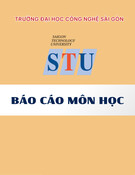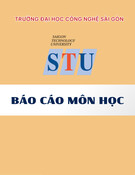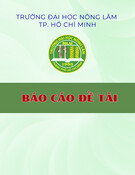
Vietnam Journal of Mathematics 33:4 (2005) 443–461
9LHWQDP -RXUQDO
RI
0$7+(0$7,&6
9$67
Central Limit Theorem for Functional of
Jump Markov Processes
Nguyen Van Huu, Vuong Quan Hoang, and Tran Minh Ngoc
Department of Mathematics
Hanoi National University, 334 Nguyen Trai Str., Hanoi, Vietnam
Received February 8, 2005
Revised May 19, 2005
Abstract. In this paper some conditions are given to ensure that for a jump homoge-
neous Markov process {X(t),t≥0}the law of the integral functional of the process:
T−1/2T
0ϕ(X(t))dt, converges to the normal law N(0,σ
2)as T→∞,whereϕis a
mapping from the state space Einto R.
1. Introduction
The central limit theorem is a subject investigated intensively by many well-
known probabilists such as Linderberg, Chung,.... The results concerning cen-
tral limit theorems, the iterated logarithm law, the lower and upper bounds of
the moderate deviations are well understood for independent random variable
sequences and for martingales but less is known for dependent random variables
such as Markov chains and Markov processes.
The first result on central limit for functionals of stationary Markov chain
with a finite state space can be found in the book of Chung [5]. A technical
method for establishing the central limit is the regeneration method. The main
idea of this method is to analyse the Markov process with arbitrary state space by
dividing it into independent and identically distributed random blocks between
visits to fixed state (or atom). This technique has been developed by Athreya -
Ney [2], Nummelin [10], Meyn - Tweedie [9] and recently by Chen [4].
The technical method used in this paper is based on central limit for mar-
tingales and ergodic theorem. The paper is ogranized as follows:
In Sec. 2, we shall prove that for a positive recurrent Markov sequence

444 Nguyen Van Huu, Vuong Quan Hoang, and Tran Minh Ngoc
{Xn,n≥0}with Borel state space (E,B)andforϕ:E→Rsuch that
ϕ(x)=f(x)−Pf(x)=f(x)−E
f(y)P(x, dy)
with f:E→Rsuch that Ef2(x)Π(dx)<∞,whereP(x, .) is the transition
probability and Π(.) is the stationary distribution of the process, the distribution
of n−1/2n
i=1 ϕ(Xi) converges to the normal law N(0,σ
2)withσ2=E(ϕ2(x)+
2ϕ(x)Pf(x))Π(dx).
The central limit theorem for the integral functional T−1/2T
0ϕ(X(t))dt of
jump Markov process {X(t),t≥0}will be established and proved in Sec. 3.
Some examples will be given in Sec. 4.
It is necessary to emphasize that the conditions for normal asymptoticity
of n−1/2n
i=1 ϕ(Xi) is the same as in [8] but they are not equivalent to the
ones established in [10, 11]. The results on the central limit for jump Markov
processes obtained in this paper are quite new.
2. Central Limit for the Functional of Markov Sequence
Let us consider a Markov sequence {Xn,n ≥0}defined on a basic probability
space (Ω,F,P) with the Borel state space (E,B), where Bis the σ-algebra
generated by the countable family of subsets of E. Suppose that {Xn,n≥0}is
homogeneous with transition probability
P(x, A)=P(Xn+1 ∈A|Xn=x),A∈B.
We have the following definitions
Definition 2.1. Markov process {Xn,n ≥0}is said to be irreducible if there
exists a σ- finite measure μon (E,B)such that for all A∈B
μ(A)>0implies ∞
n=1
Pn(x, A)>0,∀x∈E
where
Pn(x, A)=P(Xm+n∈A|Xm=x).
The measure μis called irreducible measure.
By Proposition 2.4 of Nummelin [10], there exists a maximum irreducible
measure μ∗possessing the property that if μis any irreducible measure then
μμ∗.
Definition 2.2. Markov process {Xn,n≥0}is said to be recurrent if
∞
n=1
Pn(x, A)=∞,∀x∈E,∀A∈B:μ∗(A)>0.
The process is said to be Harris recurrent if
Px(Xn∈Ai.o.)=1.

Central Limit Theorem for Functional of Jump Markov Processes 445
Let us notice that a process which is Harris recurrent is also recurrent.
Theorem 2.1. If {Xn,n≥0}is recurrent then there exists a uniquely invariant
measure Π(.)on (E,B)(up to constant multiples) in the sense
Π(A)=E
Π(dx)P(x, A),∀A∈B,(1)
or equivalently
Π(.)=ΠP(.).(2)
(see Theorem 10.4.4of Meyn-Tweedie, [9]).
Definition 2.3. AMarkovsequence{Xn,n≥0}is said to be positive recurrent
(null recurrent)if the invariant measure Πis finite (infinite).
For a positive recurrent Markov sequence {Xn,n ≥0}, its unique invariant
probability measure is called stationary distribution and is denoted by Π. Here-
after we always denote the stationary distribution of Markov sequence {Xn,n≥
0}by Π and if νis the initial distribution of Markov sequence then Pν(.),E
ν(.)
are denoted for probability and expectation operator responding to ν.Inpar-
ticular, Pν(.),E
ν(.) are replaced by Px(.),E
x(.)ifνis the Dirac measure at
x.
We have the following ergodic theorem:
Theorem 2.2. If Markov sequence {Xn,n ≥0}possesses the unique invariant
distribution Πsuch that
P(x, .)Π(.),∀x∈E, (3)
then {Xn,n≥0}is metrically transitive when initial distribution is the station-
ary distribution. Further, for any measurable mapping ϕ:E×E:→Rsuch that
EΠ|ϕ(X0,X
1)|<∞,withprobabilityone
lim
n→∞ n−1
n−1
k=0
ϕ(Xk,X
k+1)=EΠϕ(X0,X
1)(4)
and the limit does not depend on the initial distribution. (See Theorem 1.1from
Patrick Billingsley [3]).
The following notations will be used in this paper: For a measurable mapping
ϕ:E→Rwe denote
Πϕ=E
ϕ(x)Π(dx),Pϕ(x)=E
ϕ(y)P(x, dy)=E(ϕ(Xn+1)|Xn=x),
Pnϕ(x)=E
ϕ(y)Pn(x, dy)=E(ϕ(Xn+m)|Xm=x).

446 Nguyen Van Huu, Vuong Quan Hoang, and Tran Minh Ngoc
For the countable state space E={1,2, ...}we denote
Pij =P(i, {j})=P(Xn+1 =j|Xn=i),P
(n)
ij
=Pn(i, {j})=P(Xm+n=j|Xn=i)
πj=Π({j}),P=[Pij ,i,j ∈E],P
(n)=[P(n)
ij ,i,j ∈E]=Pn.
Then
Πϕ=
j∈E
ϕ(j)πj,Pϕ(j)=
k∈E
ϕ(k)Pjk,P
nϕ(j)=
k∈E
ϕ(k)P(n)
jk .
If the distribution of random variable Ynconverges to the normal distribution
N(μ, σ2)thenwedenote L
−→ N(μ, σ2). The indicator function of a set Ais
denoted by 1
1
1A,where
1
1
1A(ω)=1,if ω∈A
0,else.
Finally, the mapping ϕ:E={1,2, ...}−→Ris denoted by column vector
ϕ=(ϕ(1),ϕ(2), ...)T.
The main result of this section is to establish the conditions for
n−1/2
n
k=1
ϕ(Xk)L
−→ N(μ, σ2).
We need a central limit theorem for martingale differences as follows
Theorem 2.3. (Central limit theorem for martingale differences) Suppose that
{uk,k ≥0}is a sequence of martingale differences defined on a probability
space (Ω,F,P)corresponding to a filter {Fk,k ≥0}, i.e., E(uk+1|Fk)=0,k =
0,1,2,··· Further, assume that the following conditions are satisfied
(A1)n−1
n
k=1
E(u2
k|Fk−1)P
−→ σ2,
(A2)n−1
n
k=1
E(u2
k1
1
1[|uk|≥ε√n]|Fk−1)P
−→ 0,foreachε>0(the conditional Lin-
derberg’s condition).
Then
n−1/2
n
k=1
ukL
−→ N(0,σ
2).(5)
(see Corollary of Theorem 3.2, [7]).
Remark 1. Theorem 2.3 remains valid for {uk,k ≥0}being a m-dimensional
martingale differences where the condition (A1) is replaced by
n−1
n
k=1
Var (uk|Fk−1)P
−→ σ2=[σij ,i,j =1,2,···,m]

Central Limit Theorem for Functional of Jump Markov Processes 447
with
Var (uk|Fk−1)=[E(uikujk|Fk−1),i,j =1,2,···,m].
We shall prove the following theorem.
Theorem 2.4. (Central limit theorem for functional of Markov sequence) Sup-
pose that the following conditions hold:
(H1)The Markov sequence {Xn,n ≥0}is positive recurrent with the transition
probability P(x, .)and the unique stationary distribution Π(.)satisfying the
condition (3).
(H2)The mapping ϕ:E→Rcan be represented in the form
ϕ(x)=f(x)−Pf(x),x∈E, (6)
where f:E→Ris measurable and Πf2<∞.
Then
n−1/2
n
k=1
ϕ(Xk)L
−→ N(0,σ
2)(7)
for any initial distribution, where
σ2=Π(f2−(Pf)2)=Π(ϕ2+2ϕP f ).(8)
Proof. We have
n−1/2
n
k=1
ϕ(Xk)=n−1/2
n
k=1
[f(Xk)−Pf(Xk)]
=n−1/2
n
k=1
[f(Xk)−Pf(Xk−1)] + n−1/2
n
k=1
Pf(Xk−1)−n−1/2
n
k=1
Pf(Xk)
=n−1/2
n
k=1
uk+n−1/2[Pf(X0)−Pf(Xn)],
where
uk=f(Xk)−Pf(Xk−1)=f(Xk)−E(f(Xk)|Xk−1)
are martingale differences with respect to Fk=σ(X0,X
1,···,X
k), whereas
n−1/2[Pf(X0)−Pf(Xn)] P
−→ 0
by Chebyshev’s inequality. Thus, it is sufficient to prove that
Yn:= n−1/2
n
k=1
ukL
−→ N(0,σ
2)
and the convergence does not depend on the initial distribution. For this pur-
pose, we shall show that the martingale differences {uk,k ≥1}satisfy the con-
ditions (A1),(A2).
Accordingtoassumption(H2)wehave
















